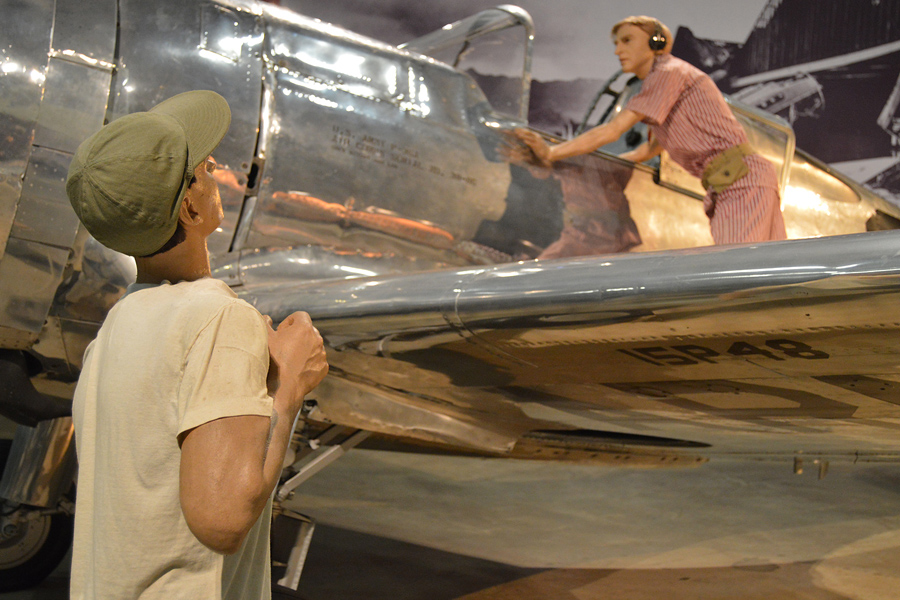A Day that Will Live in Infamy
The Japanese attack on Pearl Harbor, Hawaii, on the morning of Dec. 7, 1941, completely surprised American forces. Japanese carrier-borne bombers and fighters devastated the Army Air Forces, Navy and Marine installations on the island of Oahu. The attack killed or wounded almost 3,500 Americans. Opposition to the attack was disorganized and mostly ineffective. Though many pilots survived the attacks, few aircraft were fit to fly. At Wheeler Field, four pilots, including Lt. Philip Rasmussen, were able to take off in outdated P-36A aircraft and engage the enemy over Kaneohe Bay.
The museum’s P-36A exhibit depicts Rasmussen preparing to take off under fire in his P-36A. The actions of Rasmussen and his fellow pilots, while unable to change the course of the battle, were heroic examples of how American forces kept fighting even in the midst of crushing defeat.
Caught by Surprise
The Army and Navy installations on Oahu were ill-prepared for the Japanese attack. Though the leadership of both the Pacific Fleet and the Army Air Forces in Hawaii had been made aware of a possible Japanese offensive, few measures were in place to defend the American bases.
The senior Army staff feared sabotage by Japanese sympathizers on Oahu more than a surprise air attack. For ease of guarding, all aircraft were parked wingtip-to-wingtip on the flight line, rather than in earthen revetments built to protect them from a mass attack. Antiaircraft ammunition was stored far from the aircraft in a central location.
On the morning of Dec. 7, both Army and Navy personnel ignored signs of the impending attack. The destroyer Ward sank a Japanese midget submarine in the mouth of the harbor at 6:54 a.m.; the staff of Admiral Kimmel, commanding officer of the Pacific Fleet, was not informed until 7:25. An Army radar station detected the scout aircraft sent ahead of the main Japanese force at 6:45. The officer on duty decided these were B-17s arriving from California and did not relay the information further. At 7:53, the commander of the first wave of Japanese pilots radioed, “Tora, Tora, Tora,” the code words for a successful surprise approach, back to the Japanese fleet. At 7:55, the attack began.
Destruction of the Airfields
The destruction of the Army Air Forces fields on the island of Oahu was a vital part of the Japanese battle plan. Though the target of the attack was the Pacific Fleet, the Japanese did not want to engage in an all-out battle with Army and Navy pilots. Japan feared that long-range American aircraft could trace departing Japanese aircraft back to their ships. Quick and complete destruction of the aircraft on Oahu was crucial for the Japanese attack to succeed.
Three Army airfields — Hickam, Wheeler and Bellows Fields — were targeted by the Japanese. The initial attack struck Wheeler and Hickam Fields, destroying aircraft, maintenance hangars and other structures. The base chapel, mess hall and barracks at Hickam also suffered serious damage. A second wave of Japanese aircraft struck Wheeler and Hickam Fields about one hour after the first attack ended. During the second attack, Japanese aircraft also strafed tents, buildings and aircraft at Bellows Field. At the conclusion of the Japanese offensive, almost 700 Army Air Forces personnel were dead and wounded, and more than two-thirds of the air power on Oahu was damaged or destroyed.
Dogfight Over Kaneohe
Opposition to the Japanese attack was scattered and disorganized. Army personnel shot at Japanese aircraft with everything from antiaircraft guns to pistols. One of the few pilots who managed to engage enemy aircraft was 2nd Lt. Philip M. Rasmussen of the 46th Pursuit Squadron. He had just arisen when the attack began. Still wearing his pajamas, Rasmussen sped toward the flight line.

At the flight line, all of the aircraft were destroyed or burning except for a few P-36 Hawks. Rasmussen jumped in one and taxied to a revetment at the edge of the airfield, where he joined three other pilots also preparing undamaged P-36 fighters. The pilots took off under fire, and were directed by radio toward Kaneohe Bay where they engaged 11 Japanese fighters in battle.
After shooting down one Japanese aircraft, Rasmussen was attacked by two Japanese Mitsubishi A6M2 Zero fighters. Gunfire and 20mm cannon shells shattered the canopy, destroyed the radio and severed the P-36’s hydraulic lines and rudder cable. Rasmussen sought refuge in nearby cloud cover and began flying back toward Wheeler Field. He landed the P-36 without brakes, rudder or tailwheel, and with more than 500 bullet holes.
For his actions, Rasmussen received the Silver Star. He survived the war, shooting down a second Japanese aircraft in 1943. He retired from the Air Force in 1965.
Additional Reading
At Dawn We Slept by Gordon W. Prange
Pearl Harbor: The Verdict of History by Gordon W. Prange

